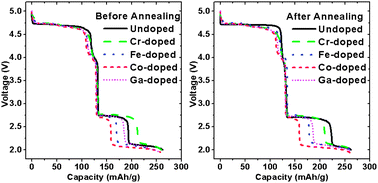Influence of doping on the cation ordering and charge–discharge behavior of LiMn1.5Ni0.5−xMxO4 (M = Cr, Fe, Co, and Ga) spinels between 5.0 and 2.0 V
Abstract
The charge–discharge behaviors of doped high-voltage spinel

* Corresponding authors
a
Electrochemical Energy Laboratory & Materials Science and Engineering Program, The University of Texas at Austin, Austin, Texas 78712, USA
E-mail:
rmanth@mail.utexas.edu
Fax: +1 (512) 471-7681
Tel: +1 (512) 471-1791
The charge–discharge behaviors of doped high-voltage spinel

 Please wait while we load your content...
Something went wrong. Try again?
Please wait while we load your content...
Something went wrong. Try again?
E. Lee and A. Manthiram, J. Mater. Chem. A, 2013, 1, 3118 DOI: 10.1039/C2TA01171A
To request permission to reproduce material from this article, please go to the Copyright Clearance Center request page.
If you are an author contributing to an RSC publication, you do not need to request permission provided correct acknowledgement is given.
If you are the author of this article, you do not need to request permission to reproduce figures and diagrams provided correct acknowledgement is given. If you want to reproduce the whole article in a third-party publication (excluding your thesis/dissertation for which permission is not required) please go to the Copyright Clearance Center request page.
Read more about how to correctly acknowledge RSC content.
 Fetching data from CrossRef.
Fetching data from CrossRef.
This may take some time to load.
Loading related content
